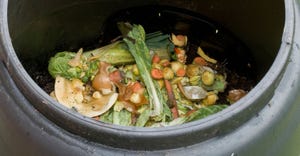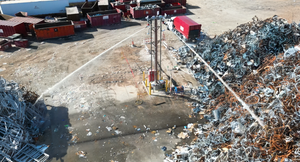What Brands are Shifting from Tree Feedstocks and How
Forest degradation is accelerating rapidly, with global forest areas having declined by about 178 million (hectares) from 1990 to 2020, leading to release of carbon to the atmosphere stored in these natural spaces. The paper packaging and fashion industries are among largest contributors to the depletion of these resources, with billions of trees cut down each year to make their products.

Forest degradation is accelerating rapidly, with global forest areas having declined by about 178 million (hectares) from 1990 to 2020, leading to release of carbon to the atmosphere stored in these natural spaces.
The paper packaging and fashion industries are among largest contributors to the depletion of these resources, with billions of trees cut down each year to make their products.
Nicole Rycroft, founder and executive director of environmental not-for-profit Canopy, discusses how she works with which brands to advance alternatives to sourcing feedstock from forests. She tells of new technologies used in packaging and fabric that is normally made from Ancient and Endangered Forests. And shares the story of how she worked with publisher Raincoast to “green” the Harry Potter book series.
Waste360: What’s going on in forests that drives your work to advance alternatives to cutting down trees to make products?
Rycroft: Forest conservation is projected to be one third of the solution for fighting climate change and limiting global temperature rises to 1.5-degree Celsius or 2.7-degrees Fahrenheit.
Despite this, every year, around 3.2 billion trees are cut down for paper packaging or fashion fabrics like viscose, many from the world’s oldest, most carbon- and biodiversity-rich forests. The loss of these forests not only endangers climate action, but risks massive biodiversity loss (forests are home to 80 percent of the world’s biodiversity).
[The impact] is unleashing of new pandemics and threats to the livelihoods of millions of Indigenous and other local communities.
Waste360: What brands do you work with and what problems are you helping them solve around use of paper or wood?
Rycroft: Canopy works with hundreds of world-leading fashion and consumer brands - including H&M, Amazon, Ben & Jerry’s, Target, Walmart, Stella McCartney, Kering, LVMH, Gap, and Levi’s—to shift their packaging, paper, and viscose supply chains off of trees and towards more sustainable alternatives often derived from waste, to ensure the world’s most vital forests don’t end up as packaging for consumer products, takeout containers, or next season's fashion.
To date, 341 companies have signed on to Canopy's Pack4Good initiative to transform their packaging supply chains. Additionally, through our CanopyStyle initiative, more than 487 brand partners have committed to transforming their viscose supply chains to ensure Ancient and Endangered Forests are no longer logged to make viscose and rayon clothing.
Waste360: What are Next Gen Solutions, and what’s their status on the path to commercialization?
Rycroft: Next Gen Solutions encompass smart logistics systems and product redesign, like reusable shipping boxes and clothing rental services.
Next Gen Solutions use innovative sources of fiber, that would otherwise be burned or landfilled, to make paper packaging and viscose textiles. With the rapid scaling and uptake of Next Gen Solutions, we can protect 30 to 50 percent of the world’s forests by 2030 to hit planetary targets and secure supply of materials.
Modern Next Gen technologies are already coming onto market to make paper from agricultural residues like leftover wheat straw, and to make viscose/Lyocell textiles from used cotton fabric or microbial cellulose. Canopy works with 30 Next Gen ventures across the textile, paper, and packaging spaces.
NextGen Solutions carry a far lighter carbon, habitat, water, and chemical footprint than conventional wood-based fabrics. On average, they consume 75 percent less energy, up to 90 percent less water, use greener or no chemicals in the production process, and include zero forest habitat. They are also identical - or better - in functionality than traditional options.
Millions of tons of Next Generation fibers are available today with more coming online as new Next Gen technologies scale to be used in packaging and fabric materials normally made from Ancient and Endangered Forests.
Waste360: Can you share a couple of stories showing what some of your brand partners are doing?
Rycroft: We’ve worked with Lush to prioritize the development of a reduction and reuse strategy for their existing wood-based products so that they don’t go to waste. Lush has also committed to using Canopy's Ecopaper database and The Paper Steps as a guide for environmentally ethical paper and packaging sourcing.
One of the global retailers we’ve collaborated with has redesigned its single-use, warehouse-to-store shipping box so that it can be re-used an average of six times before the box is recycled. In doing so, the company now uses 83 percent fewer resources to ship products to stores, saving tens of millions of dollars every year and significantly reducing its environmental impact.
Several of our fashion brand partners have committed to use 50 percent less raw materials by 2030. Smart design and Next Generation will be critical to meeting those ambitious targets.
Waste360: What kinds of materials and products are sourced from forests that we might not think are? Who is coming up with what alternatives?
Rycroft: Viscose is a widely used fabric made from wood pulp. With encouragement and uptake from the over 480 fashion brands in the CanopyStyle initiative, viscose producers are starting to make this fabric out of recycled textiles — like sewing factory scraps or post-consumer clothing.
Other products that may be surprising that can contain forests include food products like ice-cream, as well as the coating on glasses, and computer screens.
Sweden’s Renewcell makes pulp for viscose textiles from recycled clothing and is opening a new commercial-scale mill this Fall.
Craste, an innovation partner in India, has made a six-pack case for Corona beer using 100 percent barley straw. Releaf, in Ukraine, turns fallen leaves into paper and packaging. Fibers365, in Germany, uses proprietary technology that turns crop residue fibers into packaging. Notpla is using seaweed residue, also for packaging. All of these innovators are creating low-impact alternatives to wood-based packaging that are available for wider usage and ready to scale.
Waste360: How much more has to happen to make impact at scale?
Rycroft: Our ‘Survival: A Pulp Thriller - A Plan for Saving Forests and Climate’ serves as a Next Generation action plan that maps out how to conserve and/or restore at least 30 percent of the world’s forests by 2030. To make this possible, we need to replace 50 percent of the forest fiber and 100 percent of Ancient and Endangered forests that are used to make pulp, paper, packaging, and viscose with low-carbon Next Gen alternative feedstocks. All new pulp mills being built in the world need to be built to rely on Next Generation feedstock, not forests.
In Survival, we’ve mapped where there is a concentration of Next Generation materials globally, where mills could be located, and the scale of investment needed to build these mills. Canopy is partnering with investors, innovative technology ventures, pulp producers, manufacturers, governments, and corporate buyers of wood pulp–derived products to make this vision a reality.
Waste360: Tell us how you worked with the publisher of the Harry Potter series to model how a high-profile product could capture the value of forests at scale.
Rycroft: In 2003, we worked with Raincoast Books to help them source Ancient Forest Friendly papers to use in the printing of Harry Potter and the Order of the Phoenix. The result was that the Canadian edition was printed on 100 percent post-consumer recycled paper.
Two years later, Harry Potter and the Half-Blood Prince was printed on Ancient Forest Friendly papers in eight countries.
We leveraged that success and Harry Potter and the Deathly Hallows was printed on eco-friendly papers in 24 countries and in more than eight languages (12 million copies in the U.S. alone), Australia, Canada, Israel, the U.K., Spain, France, Finland, Japan, Germany, and Argentina.
Forty new eco-papers were developed for the Harry Potter books. Many of them are still regular papers used by publishers today. The final Harry Potter book was considered to be the greenest book in publishing history and more importantly it changed practices throughout the global industry.
Waste360: What’s next for Canopy?
Rycroft: Next for Canopy is scaling up Next Generation solutions around the world at the pace that is needed ecologically and bringing our plan ‘Survival’ to life. We have a decade to take 50 percent of the forest fiber currently in global supply chains out of it in order to preserve biodiversity and protect the climate. We are going to work with our growing list of brand partners to do just that.
We are starting to work with investors to bring the financing that’s needed to scale these game-changing Next Gen solutions. We encourage brands and investors wanting to make a difference to join us.
NOTE: This article has been edited for length.
About the Author
You May Also Like




